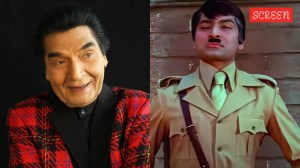Truth needs no armour
Dear General Malik,Thank you very much for your very thoughtful response to my `National Interest' article, `Dangers of Military Myths', c...

Dear General Malik,
Thank you very much for your very thoughtful response to my `National Interest’ article, `Dangers of Military Myths’, carried last Saturday. It is flattering and heartening that the serving chief of the largest service, and that too a soldier of your eminence and track record, has chosen to respond to the article in such candid detail. Sure enough, you have set us thinking again.
You say you were an army officer with six years’ service when the 1965 war took place. I was then a student of class four. For those of my generation, every “myth” of the 1965 war was authentic history. It was a very important part of our lives then, the stories of the valour of Havildar Abdul Hameed, Col Tarapore and others; the superiority of the Gnat; the graveyards of the Patton, etc. But 35 years down the line, I suppose, we could look at all that a bit dispassionately. We might actually gain from doing so.
As you put it so correctly, chroniclers of war do tend to write their own partisan perceptions. The emotions that charge a period of war are too intense to allow for instant verification, introspection or the usual application of academic rigour, or journalistic scepticism. Therefore,Hemingway made his famous statement: When war breaks out, truth is the first casualty.
Surely we know the Battle of Britain didn’t exactly take place in the way the movies tell us. Nor were the Allied generals so utterly brilliant, their troops so incredibly courageous, as to give the bumbling Germans and the fumbling Japs no hope in hell. All military history is coloured. It is just that the winning side also gets the better of the historical exchanges.
That is why the new literature — mostly Indian — on the 1965 war is so important. For both, a professional like you who, as a young captain, formed the cutting edge of that war for India, and someone like me who, as an eight year old, applauded every Akashvani bulletin during those fateful days, the new claims, counterclaims and revelations bring an opportunity to sift the myths from the reality.
You have made some very telling points about how a joint interservice effort made such a difference in Kargil. In 1965, on all evidence, it wasn’t there and while what you say about our system breeding single service thinking is correct, let me suggest that our history of modern warfare underlines ahesitation to use air power that is so uniquely Indian. All over the world, airmen are usually the first off the block. The induction of ground troops is considered an escalation. The Gulf War (Operation Desert Storm) is an example. In India, we have always seen the use of air power as escalation. We were shy of using it in 1962, we were late with it in 1965, we waited almost a week too long in Kargil. We have also always been shy of using air power in a direct counter-insurgency role. Couldn’t a couple of hundred close support sorties and a few more attack helicopters have made such a difference in the IPKF’s advance into Jaffna in 1987? How many army lives would it have saved?
Howsoever towering Harbakhsh Singh’s stature is, it can be nobody’s case that everything he wrote on "his" 1965 war is correct. He does, for example, so conveniently gloss over his own blunder of shoving his own battalion (4 Sikh) into counterattack in Khem Karan in search for some quick glory. It was purely an emotional and whimsical decision. Singh was the colonel of the regiment and hurled his battalion into the battle, unmindful of the fact that they were tired and had sustained many casualties already. The result was one of the greatest fiascos of that war as a bulk of the troops, including the commandant, were taken prisoner. Weary and unprepared, they walked straight into Pakistani defences.
It is possible that Singh ignored much else that he may have done wrong. Or that he put too much of the blame on the IAF. But, of the scores of IAF veterans I have had the chance to discuss that war with, not one has ever claimed that they made as much of a difference as they should have. They, however, had the good sense of learning the right lessons and the 1971 war was a different story. The same John Fricker (Battle for Pakistan) who glorified the PAF so much for its role in 1965 tried to do an encore in 1971, but no one believed him. Nor did anyone believe the boasts of Chuck Yeager, the legendary USAF pilot and the first man to break the sound barrier, who had been engaged as an advisor by the PAF in 1971. He claimed the Pakistanis "really whipped their asses in the air but lost the war on the ground" in a passing mention of the Bangladesh war in his autobiography. It was dismissed as trash.
Now, on to Kargil. I have no doubts the Kargil Review Committee which consisted of three very eminent people did its best to find the truth. But though the Army gave it all the information it asked for, the committee produced such a lemon after all. You refer to some people in the media and some lawyers glorifying the very officers under whose noses the infiltration took place. Does the Kargil Review Committee indict them? Has the Army everpunished them? To put the record straight, however, it was a series of investigations conducted by a very senior military affairs writer of this paper that established that some of the claims of this particular officer (Brigadier Surinder Singh) were wrong. But it is intriguing that the Ministry of Defence has been shy of taking any action against him. Nor has the review committee asked for his head.
Kargil was too complicated, yet too limited, a war for us to be able to afford mythologies so soon. This is particularly because it wasn’t the final chapter in the India-Pakistan military engagement, a kind of World Cup of the war across the LoC. It was merely one more chapter in the ongoing war over the Valley. That’s why we must not ignore its lessons, bitter or sweet, just because we won in the end. It is difficult to do so when almost all the generals, not merely officers up to the decision level, had already been decorated (Uttam Yudh Seva, Sarvottam Yudh Seva medals, etc) before the inquiry had reached anywhere.
A system that discourages discussion or preempts accountability risks becoming a protection racket. Take, for example, the IAF pilot who landed at Sialkot with his fully functional Gnat in the 1965 war. The Pakistanis said he surrendered with the aircraft and displayed the trophy to the whole world. He said he lost his way in the heat of battle. How did we hold him accountable? He actually rose to become an air marshal. And, although he apparently performed very well in the 1971 war, how inspiring his rehabilitation could have been to others is anybody’s guess.
Military mythology as an instrument of nation-building or regimental tradition is an interesting thought, but a questionable one. Should we, for example, see the charge of the light brigade as a foolhardy military blunder or a glorious chapter in the tradition of cavalry? From Somme to Saragarhi, Flanders to Philora and Kohima to Khem Karan, our great regiments have their own tales of heroism, valour and battle honours. All great armies cherish and savour these moments of glory in their military tradition. But the greatest ones do not ever confuse them with military history.
Since these are issues of great national interest, I felt constrained to raise them in my column last week and am, therefore, grateful that you have so graciously joined in this important debate.
The `Focus’ slot on page 9 carries more responses to `Dangers of military myths’. We welcome further correspondence on this issue. You may send responses by post or e-mail them to shekhargupta-q@express2.indexp.co.in
Surely we know the Battle of Britain didn’t exactly take place in the way the movies tell us
A system that discourages discussion or preempts accountability risks becoming a protection racket
`Sometimes there is a thin line between military myths and military traditions’
Dear Shekhar,
I read your interesting article `Dangers of military myths’. War has always been a military effort of extreme nature of a group, society or a nation. Lives are lost, the brave and not-so-brave are catapulted on to the stage. It becomes an important part of the national history, even folklore, so that future generations are appropriately inspired. This is history. It is unlikely to change even when we have near total transparency in the conduct and documentation of wars.
The 22-day war in 1965 was fought when I had six years’ service. I then did not understand much of grand strategy or even the operational art (unlike some young defence analysts of today). I would not like to comment on the official history now made public by newspapers or the late Lieutenant General Harbaksh Singh’s books on this war. I have yet to read and analyse his latest, In the Line of Duty: A Soldier Remembers. However, I would like to comment on two other issues that you have touched upon in your article, i.e., Army-Air Force cooperation and jointmanship, and the Kargil War.
The first issue has surfaced in all wars: 1962, 1965, 1971 and, to some extent, even in the Kargil War. Both the Army and the Air Force have their own essential characteristics. But militaries all over the world have now learnt that their efforts have to be synergised: planned, synchronised and, whenever necessary, executed jointly. This is essential for theoptimisation of effort and resources.
During the Kargil War, I was far more fortunate than my predecessors. After we got going, my colleague Air Chief Marshal A.Y. Tipnis (and also Admiral Sushil Kumar) and their men endeavoured to win the war jointly with us. This, however, will not prevent me from stating that our existing Higher Defence Control Structure perpetuates single service thinking. It is not conducive for the desired level of jointmanship and synergy in defence or operational planning.
You have been less than fair on the Kargil war. Pakistan took the initiative and thus it did surprise us, just as it did in the 1965 war by infiltration and subsequent attack in the Chhamb sector. The appropriate answer to your "… avoid talking about what got them in such an impossible war (Kargil)" , is the constitution of the Kargil Review Committee and its report. One of its members, for whom everyone in India has great professional respect, was a mediaperson, Shri B.G. Verghese. The Army, I state with full authority, gave the committee every bit of information it had, or was sought from it.
You have also mentioned that we rushed to hand out decorations post-Kargil. Most of the Operation Vijay decorations — over 95 per cent — have been awarded to soldiers and officers who were instrumental in notching battle victories at the levels of battalion, brigade and division. In fact, it is the media and some lawyers who have made much of the people whose performance in surveillance of their areas of responsibility contributed to the Pakistani surprise.
As a professional I, too, would like to caution everyone, even the military, on the dangers of military myths. But such myths, like many others, become part of nation building. They cannot be wished away easily. Sometimes there is a thin line between military myths and military traditions. In documenting battles and wars, there is also this human tendency to write only one’s own perception, without taking into account, or avoiding, the complete picture.
General V.P. Malik
Chief of Army Staff





- 01
- 02
- 03
- 04
- 05

























